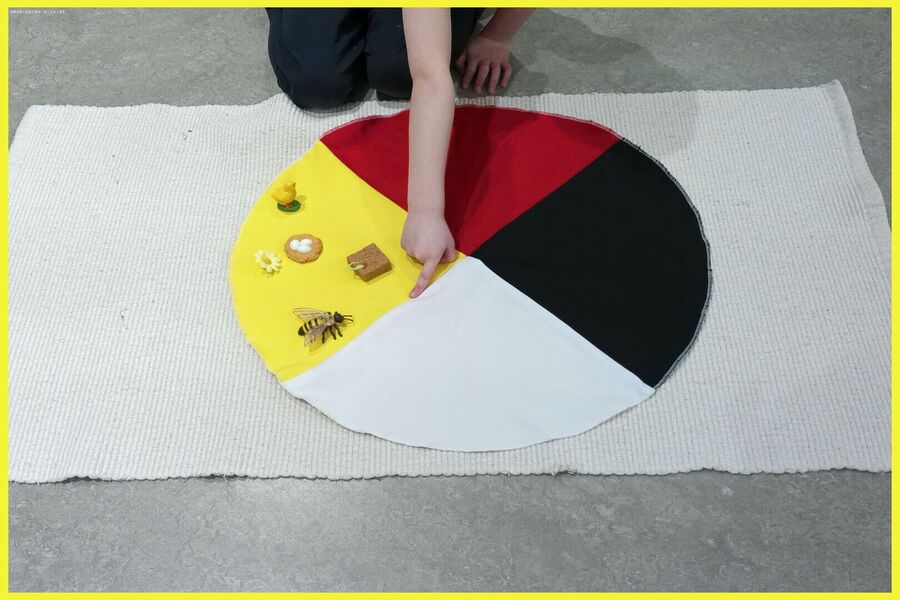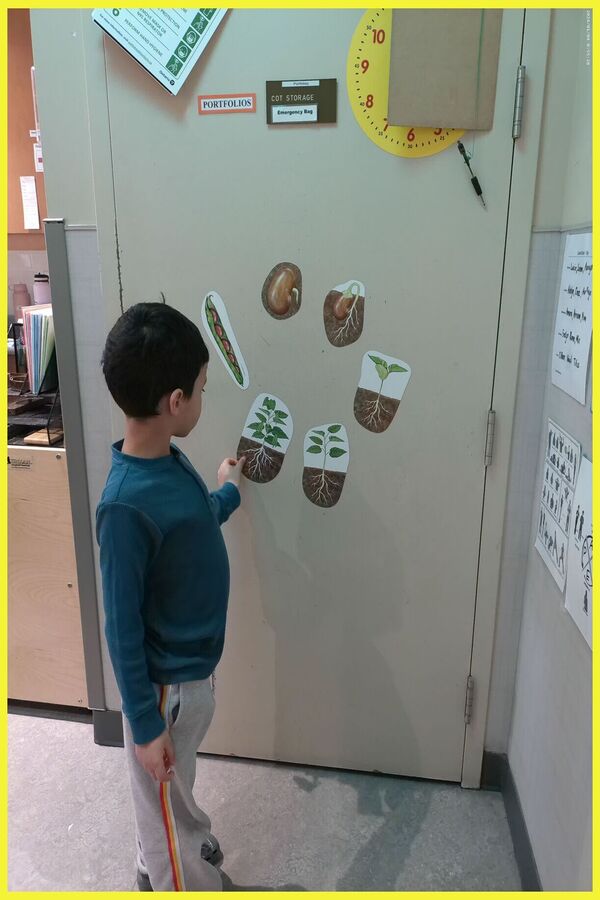
Exploring Indigenous cultures, with a particular emphasis on Anishinaabe traditions, has been the central focus of our Casa East classroom during this seasonal change. During circle time, the children embarked on an ongoing learning journey about the Spring Equinox and the lifecycle of the bean plant as a key symbol of life, nourishment and potential.

In Anishinaabe culture, the seasonal changes are deeply tied to the rhythms of nature, and the Spring Equinox marks a critical point in this cycle. This time of year is not only about the shifting of seasons but also holds profound significance in understanding the interconnectedness of all life. The Spring Equinox, on March 20th, is a moment when day and night are of equal length. It represents balance, harmony, and a time for renewal, as it signals the earth’s awakening after the stillness of winter. This change is also a reflection of the Anishinaabe understanding of life cycles, growth, and transformation.
The Significance of the Spring Equinox
For the Anishinaabe people, the Spring Equinox is a powerful symbol of balance between light and dark, day and night. It is a time when the forces of the universe are in perfect harmony, offering an opportunity to restore balance within oneself and with the natural world. The equinox serves as a reminder to live in accordance with natural cycles, to align one’s actions with the earth’s rhythms, and to be mindful of the sacredness of all living things.
In Anishinaabe tradition, the Spring Equinox is a time to celebrate renewal and express gratitude. It is a time to prepare for the coming seasons—especially the growing season—and to acknowledge the importance of mental and physical health.
The Lifecycle of the Bean Plant in Anishinaabe Culture

One of the key symbols of the changing seasons in Anishinaabe culture is the life cycle of the bean plant. Beans, along with corn and squash, are part of the “Three Sisters,” an important agricultural system that embodies the relationships between plants, the land, and people. Each of these plants has its role in maintaining balance and providing sustenance, not just for the body but for the community as a whole.
The bean plant, in particular, is deeply intertwined with Anishinaabe traditions and the way they view the world. Beans are seen as a symbol of nourishment, cooperation, and sustainability. They are planted during the spring, often around the time of the Spring Equinox, when the earth begins to warm, signaling it is time to begin the planting process. The bean plant is unique in its ability to fix nitrogen in the soil, enriching it for other plants like corn and squash. This natural partnership of the Three Sisters reflects the Anishinaabe values of mutual respect and interdependence.

The lifecycle of the bean plant mirrors many of the teachings of Anishinaabe culture. It begins as a small seed, much like a new life, and requires care, patience, and respect to grow. The planting of beans represents the act of renewal and growth, just as the Spring Equinox signals a new beginning. Beans need sunlight, warmth, and water to thrive—just as people need mental and physical nourishment. As beans grow, they also help nourish the soil, symbolizing the idea of reciprocity, where everything in the natural world has a purpose and a role to play in sustaining life. Planting beans is not only about growing food, but also about reinforcing values such as respect for the earth, gratitude for its abundance, and the need for balance in all things.

The Growth of the Bean Plant and its Teachings
As the beans begin to sprout and grow in the warmer months, they symbolize the unfolding of life and potential. In the same way that the earth nurtures the beans, the Anishinaabe teachings emphasize the nurturing role of the community in supporting one another. Beans grow in cooperation with corn and squash, teaching the value of partnership and mutual support.

By summer, the bean plants are full of leaves and blossoms, representing the fulfillment of their purpose and a successful collaboration between all elements of the ecosystem. The harvesting of beans at the end of the growing season is an expression of gratitude for the sustenance provided by the earth. The cycle of planting, nurturing, and harvesting beans mirrors the life cycle of people themselves: from birth, to growth, to maturity, and finally to death, where they give back to the earth in turn.

Conclusion The Spring Equinox in Anishinaabe culture is a time of renewal, balance, and reflection. It marks the beginning of a new cycle, as both the earth and its inhabitants awaken to the possibilities of growth and abundance. The lifecycle of the bean plant is a powerful symbol of this transition, reflecting the values of cooperation, reciprocity, and respect for the land. Through the planting of beans and the ceremonies of the Spring Equinox, the Anishinaabe people reinforce their deep connection to the earth and its cycles, recognizing that the health and well-being of the community are deeply intertwined with the natural world. The teachings of the Three Sisters, and especially the bean plant, offer lessons in balance, sustainability, and the importance of living in harmony with the earth.


